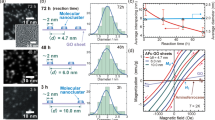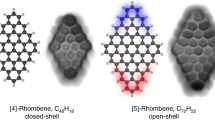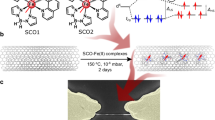Abstract
The design of nanoscale organic–metal hybrids with tunable magnetic properties as well as the realization of controlled magnetic coupling between them open gateways for novel molecular spintronic devices. Progress in this direction requires a combination of a clever choice of organic and thin-film materials, advanced magnetic characterization techniques with a spatial resolution down to the atomic length scale, and a thorough understanding of magnetic properties based on first-principles calculations. Here, we make use of carbon-based systems of various nanoscale size, such as single coronene molecules and islands of graphene, deposited on a skyrmion lattice of a single atomic layer of iron on an iridium substrate, in order to tune the magnetic characteristics (for example, magnetic moments, magnetic anisotropies and coercive field strengths) of the organic–metal hybrids. Moreover, we demonstrate long-range magnetic coupling between individual organic–metal hybrids via the chiral magnetic skyrmion lattice, thereby offering viable routes towards spin information transmission between magnetically stable states in nanoscale dimensions.
This is a preview of subscription content, access via your institution
Access options
Subscribe to this journal
Receive 12 print issues and online access
$259.00 per year
only $21.58 per issue
Buy this article
- Purchase on Springer Link
- Instant access to full article PDF
Prices may be subject to local taxes which are calculated during checkout




Similar content being viewed by others
References
Dediu, V., Murgia, M., Matacotta, F. C., Taliani, C. & Barbanera, S. Room temperature spin polarized injection in organic semiconductor. Solid State Commun. 122, 181–184 (2002).
Xiong, Z. H., Wu, D., Valy Vardeny, Z. & Shi, J. Giant magnetoresistance in organic spin-valves. Nature 427, 821–824 (2004).
Iacovita, C. et al. Visualizing the spin of individual cobalt-phthalocyanine molecules. Phys. Rev. Lett. 101, 116602 (2008).
Cinchetti, M. et al. Determination of spin injection and transport in a ferromagnet/organic semiconductor heterojunction by two-photon photoemission. Nature Mater. 8, 115–119 (2009).
Gambardella, P. et al. Supramolecular control of the magnetic anisotropy in two-dimensional high-spin Fe arrays at a metal interface. Nature Mater. 8, 189–193 (2009).
Brede, J. et al. Spin- and energy-dependent tunneling through a single molecule with intramolecular spatial resolution. Phys. Rev. Lett. 105, 047204 (2010).
Barraud, C. et al. Unravelling the role of the interface for spin injection into organic semiconductors. Nature Phys. 6, 615–620 (2010).
Atodiresei, N. et al. Design of the local spin polarization at the organic–ferromagnetic interface. Phys. Rev. Lett. 105, 066601 (2010).
Javaid, S. et al. Impact on interface spin polarization of molecular bonding to metallic surfaces. Phys. Rev. Lett. 105, 077201 (2010).
Atodiresei, N., Caciuc, V., Lazić, P. & Blügel, S. Engineering the magnetic properties of hybrid organic–ferromagnetic interfaces by molecular chemical functionalization. Phys. Rev. B 84, 172402 (2011).
Mugarza, A. et al. Spin coupling and relaxation inside molecule–metal contacts. Nature Commun. 2, 490 (2011).
Franke, K. J., Schulze, G. & Pascual, J. I. Competition of superconducting phenomena and Kondo screening at the nanoscale. Science 332, 940–944 (2011).
Joachim, C., Gimzewski, J. K. & Aviram, A. Electronics using hybrid-molecular and mono-molecular devices. Nature 408, 541–548 (2000).
Sanvito, S. Molecular spintronics. Chem. Soc. Rev. 40, 3336–3355 (2011).
Callsen, M., Caciuc, V., Kiselev, N., Atodiresei, N. & Blügel, S. Magnetic hardening induced by nonmagnetic organic molecules. Phys. Rev. Lett. 111, 106805 (2013).
Kawahara, S. L. et al. Large magnetoresistance through a single molecule due to a spin-split hybridized orbital. Nano Lett. 12, 4558–4563 (2012).
Schwöbel, J. et al. Real-space observation of spin-split molecular orbitals of adsorbed single-molecule magnets. Nature Commun. 3, 953 (2012).
Khajetoorians, A. A., Wiebe, J., Chilian, B. & Wiesendanger, R. Realizing all-spin-based logic operations atom by atom. Science 332, 1062–1064 (2011).
Gambardella, P. et al. Giant magnetic anisotropy of single cobalt atoms and nanoparticles. Science 300, 1130–1133 (2003).
Heinrich, A. J., Gupta, J. A., Lutz, C. P. & Eigler, D. M. Single-atom spin-flip spectroscopy. Science 306, 466–469 (2004).
Meier, F., Zhou, L., Wiebe, J. & Wiesendanger, R. Revealing magnetic interactions from single-atom magnetization curves. Science 320, 82–86 (2008).
Loth, S., Baumann, S., Lutz, C. P., Eigler, D. M. & Heinrich, A. J. Bistability in atomic-scale antiferromagnets. Science 335, 196–199 (2012).
Khajetoorians, A. A. et al. Current-driven spin dynamics of artificially constructed quantum magnets. Science 339, 55–59 (2013).
Heinze, S. et al. Spontaneous atomic-scale magnetic skyrmion lattice in two dimensions. Nature Phys. 7, 713–718 (2011).
Decker, R. et al. Atomic-scale magnetism of cobalt-intercalated graphene. Phys. Rev. B 87, 041403 (2013).
Raman, K. V. et al. Interface-engineered templates for molecular spin memory devices. Nature 493, 509–513 (2013).
Ouazi, S. et al. Magnetization reversal of individual Co nanoislands. Phys. Rev. Lett. 108, 107206 (2012).
Menzel, M. et al. Information transfer by vector spin chirality in finite magnetic chains. Phys. Rev. Lett. 108, 197204 (2012).
Kresse, G. & Hafner, J. Ab initio molecular dynamics for liquid metals. Phys. Rev. B 47, 558–561 (1993).
Kresse, G. & Furthmüller, J. Efficient iterative schemes for ab initio total-energy calculations using a plane-wave basis set. Phys. Rev. B 54, 11169–11186 (1996).
Acknowledgements
The authors acknowledge financial support from the Deutsche Forschungsgemeinschaft (SFB 668 and SPP 1538) and from the European Union (ERC Advanced Grant FURORE). Computations were performed under the auspices of the Kommision zur Vergabe von Supercomputing Ressourcen (computer JUROPA) and the Gauss Centre for Supercomputing (the high-performance computer JUQUEEN operated by the Jülich Supercomputing Centre at the Forschungszentrum Jülich). J.B. is grateful for insightful discussions with A. Kubetzka and K. von Bergmann and for help from R. Decker before this project.
Author information
Authors and Affiliations
Contributions
J.B. and N.A. conceived the experiment. J.B. carried out the measurements and analysed the experimental data. M.B. supported the measurements. N.A., V.C. and A.A-Z. carried out and analysed the DFT calculations. J.B. and R.W. wrote the manuscript. All authors discussed the results and commented on the manuscript.
Corresponding authors
Ethics declarations
Competing interests
The authors declare no competing financial interests.
Supplementary information
Supplementary Information
Supplementary Information (PDF 4806 kb)
Supplementary Movie
Supplementary Movie (WMV 7005 kb)
Rights and permissions
About this article
Cite this article
Brede, J., Atodiresei, N., Caciuc, V. et al. Long-range magnetic coupling between nanoscale organic–metal hybrids mediated by a nanoskyrmion lattice. Nature Nanotech 9, 1018–1023 (2014). https://doi.org/10.1038/nnano.2014.235
Received:
Accepted:
Published:
Issue Date:
DOI: https://doi.org/10.1038/nnano.2014.235
This article is cited by
-
Probing the pinning strength of magnetic vortex cores with sub-nanometer resolution
Nature Communications (2020)
-
Activating the molecular spinterface
Nature Materials (2017)
-
Spin-communication channels between Ln(III) bis-phthalocyanines molecular nanomagnets and a magnetic substrate
Scientific Reports (2016)
-
Nanoscale magnetic skyrmions in metallic films and multilayers: a new twist for spintronics
Nature Reviews Materials (2016)
-
Beating the Stoner criterion using molecular interfaces
Nature (2015)



